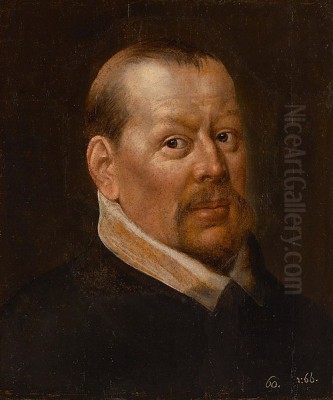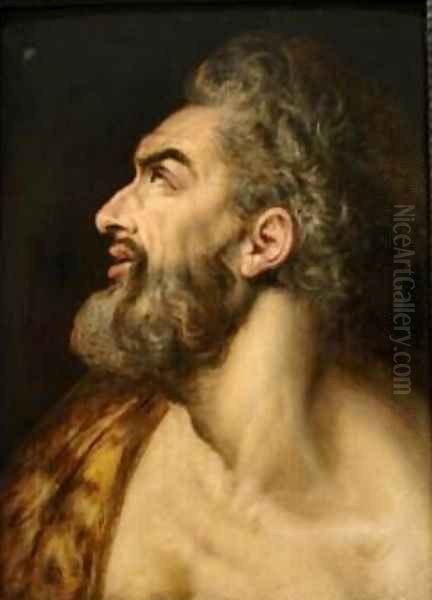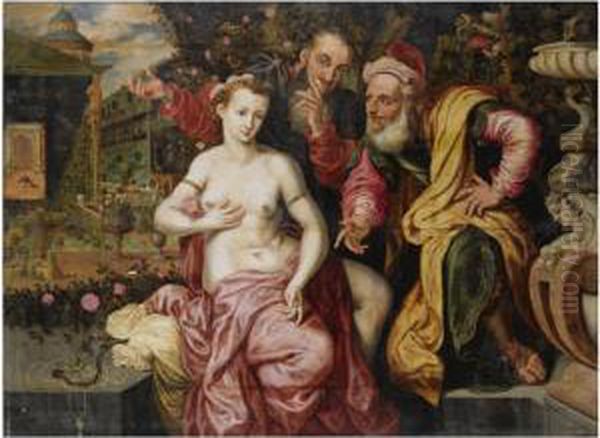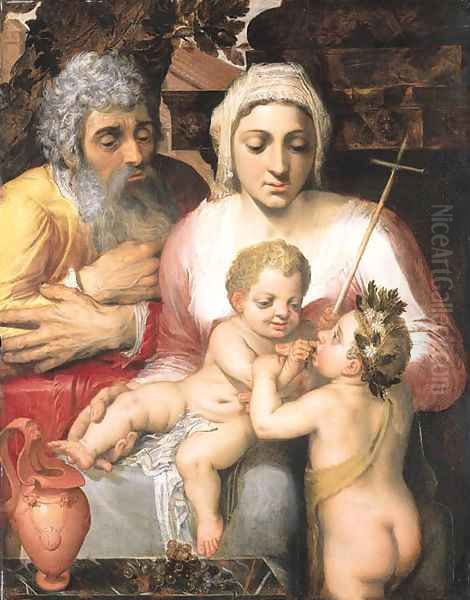
Frans Floris the Elder, also known as Frans Floris de Vriendt, stands as a seminal figure in the art history of the Southern Netherlands during the 16th century. Born in the bustling artistic hub of Antwerp around 1519 or 1520, he became a highly influential Flemish painter, draughtsman, printmaker, and even a designer of tapestries. His career unfolded during a transformative period, and he played a crucial role in shaping the Northern Renaissance, particularly the movement known as Romanism. Floris died in Antwerp on October 1, 1570, leaving behind a significant legacy.
Early Life and Artistic Formation
Floris hailed from a family deeply rooted in the arts in Antwerp. His father, Cornelis Floris I, was a respected stonemason, suggesting an environment where craftsmanship and artistic creation were valued. Initially, Frans followed a path closer to his father's trade, beginning his training in sculpture. However, his artistic inclinations soon led him towards the medium of painting, where he would ultimately make his most profound mark.
A pivotal moment in his early development was his apprenticeship under Lambert Lombard in Liège. Lombard was a significant artist and intellectual in his own right, known for his enthusiasm for Italian art and classical antiquity. According to some accounts from the period, Lombard himself had connections to earlier masters like Mabuse (Jan Gossaert), highlighting a lineage of artistic transmission. It was under Lombard's guidance that Floris likely first encountered the power and sophistication of the Italian Renaissance masters, igniting a passion that would define his career.
The Transformative Journey to Italy
Like many ambitious Northern European artists of his time, Floris undertook a crucial journey to Italy, likely sometime around 1541, staying until about 1547. This period was indispensable for his artistic maturation. He immersed himself in the study of classical Roman art and architecture, absorbing the principles of proportion, harmony, and idealized form. More importantly, he directly engaged with the works of the High Renaissance giants.

The influence of Michelangelo, with his dynamic figures and mastery of human anatomy, is palpable in Floris's later work. Similarly, the grace, compositional clarity, and idealized beauty found in the paintings of Raphael left an indelible mark on his artistic vision. He also studied the works of other contemporary Italian artists, such as Giulio Romano, whose Mannerist tendencies likely resonated with Floris's own developing style. This Italian sojourn was not merely about imitation; it was about absorbing a new artistic language and synthesizing it with his own Netherlandish background.
Return to Antwerp: Workshop and Influence
Upon returning to Antwerp around 1547, Floris established himself as a master painter and opened a large, highly productive workshop. He quickly gained renown, becoming one of the city's most sought-after artists, particularly for large-scale history paintings. His studio became a major center for artistic training, attracting a remarkable number of pupils and assistants, solidifying his position at the forefront of the Antwerp art scene.
His workshop operated with considerable efficiency, enabling the production of numerous commissions. Floris was a key proponent of Romanism in the North – a style characterized by the integration of Italian Renaissance ideals (such as monumental figures, classical themes, and anatomical accuracy) into the existing artistic traditions of Northern Europe. He effectively translated the grandeur and complexity of Italian models into a form that resonated with Northern patrons, significantly shaping the artistic landscape of Flanders.
Artistic Style: Bridging North and South
Frans Floris's style is defined by its ambitious synthesis of Italian Renaissance aesthetics and Flemish artistic traditions. He embraced the Italian emphasis on the human form, often depicting muscular, dynamic figures inspired by Michelangelo, arranged in complex, multi-figure compositions reminiscent of Raphael or Giulio Romano. His works frequently feature classical architecture and mythological or historical subjects, showcasing his humanist learning acquired in Italy.
However, Floris retained elements of his Northern heritage. His paintings often exhibit a richness of color and attention to detail, particularly in textures and surfaces, that are characteristic of Flemish painting. His handling of the nude figure was particularly noteworthy; he approached it with a sensitivity and anatomical understanding that was advanced for Netherlandish art at the time, combining Italian idealization with a tangible physicality that appealed greatly to collectors.

His compositions are often elaborate and dynamic, filled with figures in dramatic poses. He excelled in history painting, tackling grand religious and mythological narratives. Furthermore, Floris was an innovative portraitist. His portraits delve into the psychological presence of the sitter, moving beyond mere likeness to explore character and emotion, laying groundwork that later artists, including the great Peter Paul Rubens, would build upon. His work as a draughtsman was also crucial, both for preparatory studies and as finished works, and his designs for prints and tapestries further disseminated his style.
Masterpieces and Major Works
Frans Floris's oeuvre includes several significant works that exemplify his style and importance. Among his most celebrated paintings is The Fall of the Rebel Angels, completed in 1554 and now housed in the Royal Museum of Fine Arts Antwerp. This large, tumultuous composition showcases his mastery of complex figuration and dynamic movement, directly reflecting the influence of Michelangelo's Last Judgment. The work depicts the chaotic expulsion of Lucifer and his followers from Heaven, rendered with dramatic intensity and anatomical prowess.
Another key history painting is The Judgement of Solomon, dated around 1565 and held by the Royal Museums of Fine Arts of Belgium in Brussels. This work demonstrates his ability to handle large narrative scenes with clarity and emotional depth, presenting the biblical story with monumental figures and a carefully structured composition that balances drama and classical order.
Floris was also a gifted portrait painter. The Head Study of a Bearded Man, also in the Royal Museum of Fine Arts Antwerp, reveals his skill in capturing individual likeness and character with vigorous brushwork and psychological insight. Such studies were likely used for larger compositions but stand as powerful works in their own right. Rubens himself is known to have admired and even utilized Floris's head studies in his own work, indicating their perceived quality and usefulness.
His allegorical works, such as Peace and Justice (Antwerp Museum), demonstrate his engagement with humanist themes, using personification to convey abstract concepts in the grand Italian manner. Furthermore, Floris was a prolific designer of prints. His series depicting The Seven Virtues and The Seven Deadly Sins, created for the Antwerp nobility, were widely circulated and highly influential, helping to spread his artistic ideas far beyond his painted works. These prints are now found in various museum collections worldwide. A notable later discovery includes an unfinished panel of Susanna and the Elders, exhibited at TEFAF Maastricht in 2019, offering insights into his working process and confirming his sensitive treatment of the female nude.
A Prolific Teacher: The Floris Legacy

Frans Floris was not only a successful painter but also an exceptionally influential teacher. His Antwerp workshop was one of the largest and most important training grounds for artists in the Southern Netherlands during the mid-16th century. The early biographer Karel van Mander reported that Floris may have had as many as 120 students and assistants pass through his studio, a testament to his fame and the demand for training under his guidance. Van Mander noted that Floris's pupils compiled a list of their own number after his death, confirming this large figure.
Among his documented pupils were several artists who went on to have significant careers, ensuring the continuation and adaptation of his Romanist style. Notable students included:
Joos de Beer: Who later became the teacher of the important Utrecht painter Abraham Bloemaert, thus extending Floris's influence into the Northern Netherlands.
Crispijn van den Broeck: A painter and designer who worked closely with Floris, even helping to complete some of his master's works towards the end of his life. He became a successful artist in his own right.
Frans Pourbus the Elder: Another highly successful pupil who became a leading portrait and history painter in Antwerp.
Marten van Cleve I: Known for his genre scenes and landscapes, demonstrating the diversity of talent emerging from Floris's workshop.
Lucas de Heere: A painter and poet who worked in Ghent and was also known for his portraits and historical subjects.
Marten de Vos: Became one of Antwerp's leading history painters after Floris's death.
Ambrosius Francken I and Frans Francken I: Brothers who became part of the extensive Francken dynasty of painters active in Antwerp for generations. Frans Francken I, in particular, carried forward a style clearly indebted to Floris.
Hendrick van den Broeck: Another painter from the van den Broeck family associated with Floris.
Frans Menton: Known for his work in Alkmaar, particularly militia group portraits (schutterstukken).
Isaac Claesz van Swanenburg: Became a prominent painter in Leiden.
George Boba: Another documented pupil.
Through this extensive network of students, Floris's artistic principles – the fusion of Italian grandeur with Northern detail, the emphasis on the human figure, and the engagement with classical themes – were widely disseminated throughout the Low Countries and beyond. His workshop served as a crucial conduit for transmitting Italian Renaissance ideas northward, profoundly impacting the development of Flemish and Dutch art in the late 16th and early 17th centuries.
Contemporaries and Artistic Milieu
Frans Floris operated within a vibrant artistic context in 16th-century Antwerp, a major European center for art production and trade. His primary mentor, Lambert Lombard, was instrumental in shaping his early direction. Lombard himself was part of a generation keen on absorbing Italian influences, looking back to predecessors like Jan Gossaert (Mabuse) who were among the first Netherlandish artists to travel south and adopt Renaissance motifs.
While direct collaboration with Peter Paul Rubens was impossible due to chronology (Rubens was born seven years after Floris died), Floris's impact on the later master is undeniable. Rubens, a towering figure of the Baroque, clearly studied and learned from Floris's work. Floris's large-scale history paintings, his dynamic compositions, and his powerful rendering of the human form provided important precedents for Rubens's own monumental style. As mentioned, Rubens's use of Floris's head studies confirms this connection. Floris's pioneering work in Antwerp history painting and portraiture helped pave the way for the artistic environment in which Rubens would later flourish.
Floris also interacted with the broader artistic community through collaborations, particularly with printmakers who engraved his designs, making his compositions accessible to a wider audience. His connections likely extended to other Antwerp painters and possibly even descendants of earlier masters like Jan van Eyck, though specific records of these interactions are scarce. His influence is also seen in the work of artists who may not have been direct pupils but were certainly aware of his dominant style, such as members of the Francken family and painters like Frans Pourbus I. The biographer Karel van Mander, writing a few decades after Floris's death in his Schilder-boeck (1604), provided much of the information we have about Floris's life, students, and reputation, cementing his place in art history.
Later Life: Success and Struggles
Despite his artistic success and the productivity of his workshop, Frans Floris's later years were marked by personal and professional difficulties. Contemporary accounts suggest he adopted a lavish and perhaps dissolute lifestyle, which led to financial problems and mounting debts towards the end of his life. There are also reports, notably from Van Mander, that excessive drinking began to impair his ability to work, necessitating assistance from pupils like Crispijn van den Broeck to complete commissions.
A major external blow came with the Beeldenstorm, or Iconoclastic Fury, that swept through the Netherlands in 1566. Mobs protesting against the perceived idolatry of Catholic imagery destroyed vast amounts of religious art in churches and monasteries. Antwerp was hit particularly hard, and many of Floris's works, especially altarpieces and religious commissions, were lost forever. This destruction not only represented a tragic loss of cultural heritage but also significantly impacted Floris's extant body of work and likely contributed to his financial woes. These combined factors – personal struggles and the turbulent socio-political climate – cast a shadow over his final years.
Death and Enduring Reputation
Frans Floris the Elder died in Antwerp on October 1, 1570, at the age of about 50. He passed away burdened by debt, a somewhat somber end for an artist who had reached such heights of fame and influence. His death occurred amidst ongoing religious and political turmoil that would soon escalate into the Dutch Revolt.
In the centuries following his death, Floris's reputation has fluctuated. He was highly esteemed by his contemporaries and immediate successors, recognized as the leading figure who successfully imported the Italian grand manner to Flanders, earning him the moniker "the Flemish Raphael." His influence on the next generation of artists, including those who would shape the Flemish Baroque, was profound.
However, later critics sometimes viewed his work as overly dependent on Italian models, suggesting a lack of originality compared to either the Italian masters he emulated or the distinct Netherlandish traditions of artists like Pieter Bruegel the Elder. Some found his style overly rhetorical or academic. Nevertheless, his technical skill, his role in transmitting Renaissance ideals, his powerful compositions, and his impact as a teacher have never been seriously disputed.
In recent times, renewed scholarly interest and the occasional discovery of previously unknown works, like the Susanna and the Elders panel, have helped to reaffirm his importance. Today, Frans Floris is recognized as a pivotal figure in 16th-century European art, a master whose work provides a crucial link between the Italian High Renaissance and the development of painting in Northern Europe.
Conclusion: A Bridge Between Worlds
Frans Floris the Elder occupies a central and complex position in the history of Northern European art. As a leading master of Romanism in Antwerp, he successfully navigated the challenge of integrating the monumental forms, classical subjects, and anatomical understanding of the Italian Renaissance with the rich colors, detailed execution, and expressive potential of his native Flemish tradition. His large workshop trained a generation of artists, disseminating his influential style throughout the Low Countries. Though his later life was troubled and much of his work lost, his surviving paintings, drawings, and print designs testify to his ambition, skill, and historical significance. He remains a key figure for understanding the dynamic cultural exchange that characterized the Northern Renaissance and paved the way for the artistic glories of the following century.